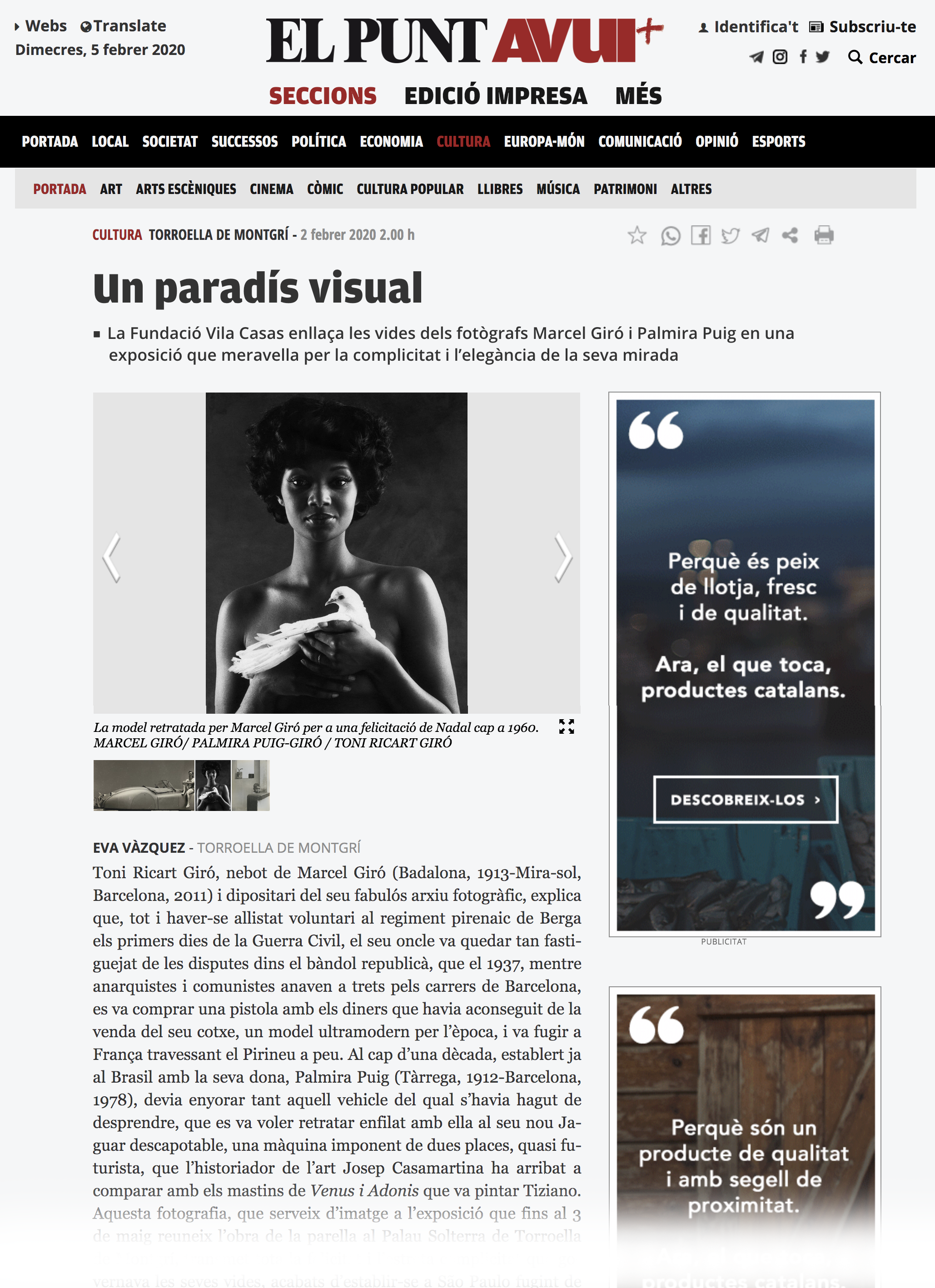Marcel Giró

Media
A visual paradise
El Punt Avui.
Eva Vàzquez
The Fundació Vila Casas links the lifes of the photographers Marcel Giró and Palmira Puig in an exhibition that marvels at the complicity and elegance of their gaze
Toni Ricart Giró, nephew of Marcel Giró (Badalona, 1913-Mira-sol, Barcelona, 2011) and the keeper of his fabulous photographic archive, explains that, despite having volunteered to join the Berga Pyrenean regiment in the early days of the Civil War, his uncle was so disgusted by the disputes within the Republican camp, that in 1937, while anarchists and communists were shooting each other in the streets of Barcelona, he bought a gun with the money he had earned from the sale of his car, an ultra-modern model for the time, and fled to France by walking across the Pyrenees. A decade later, already established in Brazil with his wife, Palmira Puig (Tàrrega, 1912-Barcelona, 1978), he must have missed that vehicle so much that he wanted to have his new Jaguar convertible portrayed with it, an imposing, almost futuristic, two-seater machine that the art historian Josep Casamartina has come to compare with the mastiffs of Venus and Adonis painted by Titian. This photograph, which serves as an image for the exhibition that will be on display at the Palau Solterra in Torroella de Montgrí until 3 May, conveys all the happiness and close complicity that governed their lives, having just settled in São Paulo, fleeing from warlike Europe and fascinated by the modernity of a new world under construction.
That there was such a communion between them should have already made one suspect when reviewing the legacy of Marcel Giró, but it has taken decades to discover that many of the wonderful photographs attributed to him were actually by Palmira Puig. In fact, Marcel Giró himself, who after his wife's death in 1978 practically abandoned experimental photography, as if it had only made sense with her, was a late discovery in Catalonia, where it was not until 2017 that his extraordinary intuition for capturing the geometry of vision could be assessed in an exhibition organized by gallery owner Rocío Santa Cruz from the background of nearly 4,000 negatives and hundreds of contact sheets and slides that his nephew had inherited. It was by examining this material in detail that they realized that some photographs had Palmira's signature on the back, and that in others that had not raised doubts about authorship, in a corner of the negative the figure of Marcel appeared, a cut-out in the development, so that the camera could only have held it. Not only that: on the same contact sheet, there were notes from both, and images that, captured within a few seconds of each other, revealed two glances, two sensibilities, as if the Hasselblad had been exultant: now you shoot, now I shoot.
Toni Ricart admits that they are still far from being able to fully discern the work that belongs to one or the other, but the fact is that in each immersion in Giró's archive they make new discoveries. In the Torroella exhibition, there are already at least a couple of photographs by Palmira Puig identified in recent months, and the exploration of the Brazilian market, where the couple had phenomenal success not only from their advertising photography studio, but also through their link to the advanced Foto Cine Clube Bandeirante, may offer more rewarding surprises. One of them is the confirmation that Palmira Puig did not limit herself to being a simple "muse", inspiring, accompanying and helping her husband, as was believed until recently, but was the first woman admitted, in 1956, to the prestigious photographic club of São Paulo, of which only four other photographers would become members, among them Gertrudes Altschul. In fact, Brazilian photography of the 1950s and 1960s is still too little known in Europe, which is opening its eyes thanks to exhibitions such as the one Rocio Santa Cruz now dedicated a year ago to her gallery, where she first made known the talent of Palmira Puig. The exhibition now open at the Museo de la Fotografía of the Fundación Vila Casas does not go much deeper into the work of this captivating, unpublished author, but both the curator and Toni Ricart argue that the research is so incipient and so closely related to the legacy of Marcel Giró that in order to discern with certainty what corresponds to each one, one has to advance with feet of lead.
The fact is that, of the seventy photographs gathered, little more than a fortnight are undoubtedly by Palmira Puig, and the rest, up to fifty, are by her husband. It doesn't matter, because both of them frankly dazzle, by the way they look, by the way they understand each other, by the way they enjoy what they do. The difference in style is almost imperceptible, although the two experts detect a more pronounced delicacy.
Eva Vàzquez

